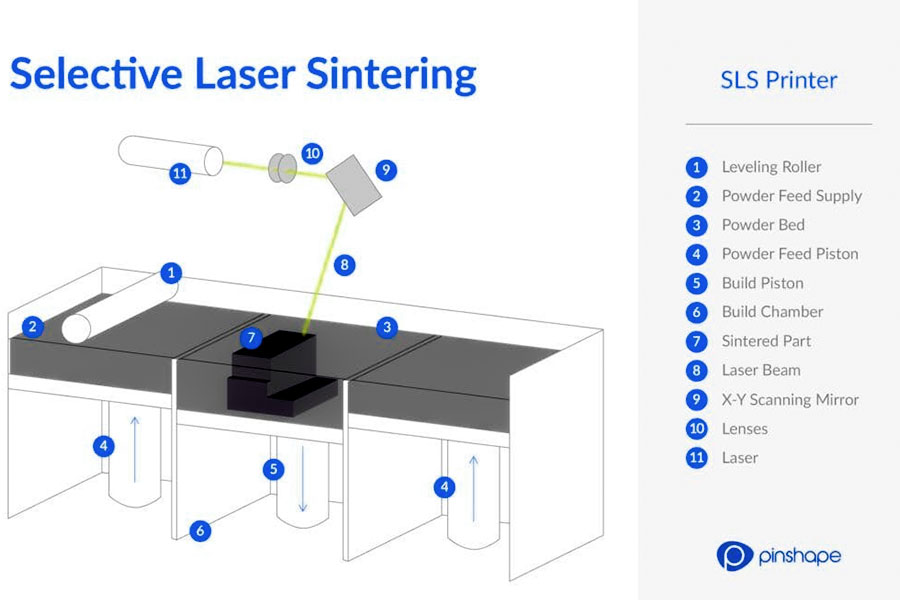How Does Selective Laser Sintering (SLS) Work?
Theworking principle of SLS technologyis based on the discrete-stacking principle. First, the powder material is preheated to a temperature slightly below its melting point, and then under computer control, the laser beam selectively sinters based on layered cross-section information. After one layer of sintering is completed, the workbench is lowered by one layer, and a new layer of powder is spread, and a new layer of cross-section is sintered. This is repeated until the entire three-dimensional solid structure is completed.
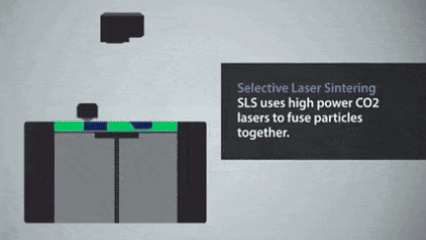
What Are the Key Steps in the Selective Laser Sintering Process?
1.Printing
TheSLS printing processis unique compared to other additive manufacturing processes such asfused deposition modeling (FDM). First, the raw powder is preheated (so the laser requires less energy) and deposited in a thin layer on top of the build chamber platform. The laser then scans or photographs slices of the powder so that their shape conforms to the model of the cross-section, sintering the material as it goes. The remaining unmelted powder acts as a support layer as the build chamber is lowered a level and more material is added. This process is repeated until the build is complete.
2.Cool down
The printed part is then suspended on a hot powder bed. To reduce defects and improve dimensional stability, the build chamber must be cooled evenly, which can account for up to half of the total build time. This cooling should be gradual, and cooling of the build chamber can reduce mechanical defects and help reduce warpage.
3.Post-processing
After cooling, excess powder is removed and recycled. To recycle parts from the build chamber, the parts need to be manually screened to remove excess powder and then cleaned with compressed air to prepare them for final processing. SLS parts are known for the uniquesurface finish produced by the sintering process. To achieve excellent material properties and finish quality, parts can be post-processed - using sandblasting and media tumbling to improve the surface finish.
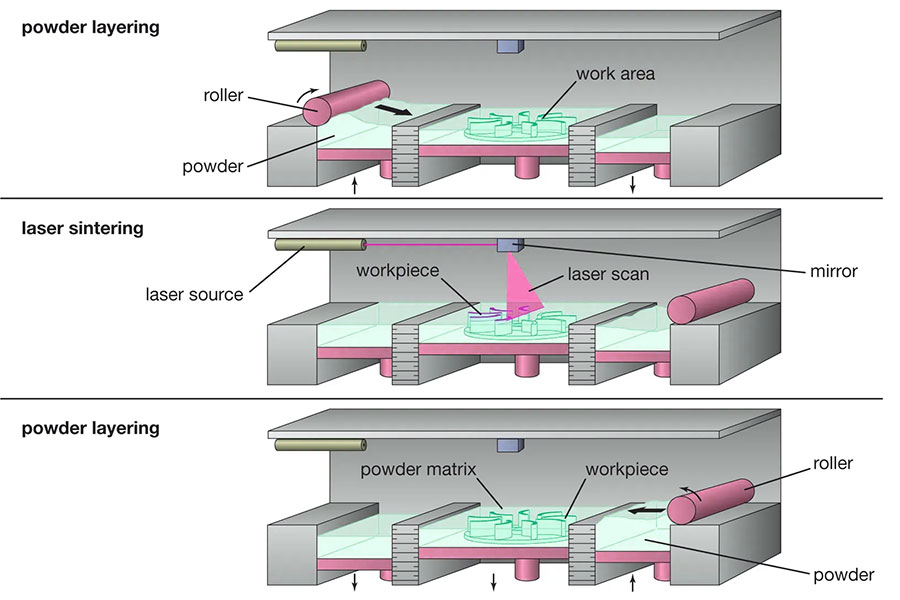
What are the advantages and disadvantages of selective laser sintering?
Theadvantages and disadvantages of selective laser sintering (SLS) technologyare as follows:
| Advantages | Disadvantages |
| In the selective laser sintering (SLS) process, the parts do not require additional support materials because the powder itself acts as a support. As long as the powder discharge path is designed, complex internal structures can be easily printed. | Compared with other 3D printing technologies such as fused deposition modeling (FDM), the types of materials available for selective laser sintering (SLS) are relatively small. In SLS, materials such as nylon, polystyrene and TPU can be used, but nylon is the most commonly used material due to its excellent properties. |
| Although SLS technology usually uses white, black or gray nylon powder, after printing, these parts can appear in a variety of different colors through a dyeing process. | Since the plastic particles are not completely melted into a homogeneous substance during the SLS printing process, but are only connected together by sintering at the ends of the particles, tiny gaps will be left in the printed parts, making the parts appear porous. |
| SLS technology is capable of printing parts with very fine and highly detailed features. This is due to the extremely small size of the laser focus, allowing the smallest feature size to be printed up to 0.75 mm. | During the SLS printing process, only about 50% of the unused powder can be recycled. This means that over time, a considerable part of the material will not be reusable. Compared with technologies such as FDM or stereolithography (SLA), SLS has a certain waste in material utilization. |
|
Compared with technologies such as fused deposition modeling (FDM) or even stereolithography (SLA), the printing speed of SLS is relatively fast because each layer of powder can be sintered by the laser almost immediately. |
Compared with SLA and FDM, the cost of SLS printing technology is higher, mainly because its core technology-using laser for material sintering-is relatively complex and professional. |
What Materials Are Used in Selective Laser Sintering?
Selective laser sintering (SLS) mainly uses the following types of materials:
1.Plastic powder:
- Nylon:including PA12, PA11, etc., is one of the most commonly used materials in SLS technology. Nylon has good mechanical properties and thermal stability, making it suitable for manufacturing a variety of functional parts and prototypes.
- Thermoplastic polyurethane (TPU):TPU has excellent elasticity and wear resistance, making it suitable for applications that require a certain degree of flexibility and durability.
In addition, suchmaterials as polystyrene (PS), polycarbonate (PC), ABS,etc. are also used in SLS technology, but are less used than nylon and TPU.
2.Metal powder:
Although metal powder is not a mainstream material in SLS technology, it is also used in some special applications.Metal powders such as titanium, aluminum, stainless steel, etc., under appropriate process conditions, can be used to manufacture parts with metallic properties through SLS technology. However, it should be noted that the SLS process of metal powder is often called selective laser melting (SLM), which is different from SLS in process.
3.Composite powder:
Composite powder is a powder formed by mixing two or more materials together. In SLS technology, composite powders can be used to increase the strength, hardness or other special properties of parts. For example, mixing glass or carbon fiber with plastic powder can create parts with greater strength and rigidity.
4.Ceramic powder:
Ceramic powders are also used in SLS technology, but are less commonly used than plastic and metal powders. Ceramic powders are often used with a binder, which melts and bonds the ceramic particles during the sintering process to form a dense ceramic part.
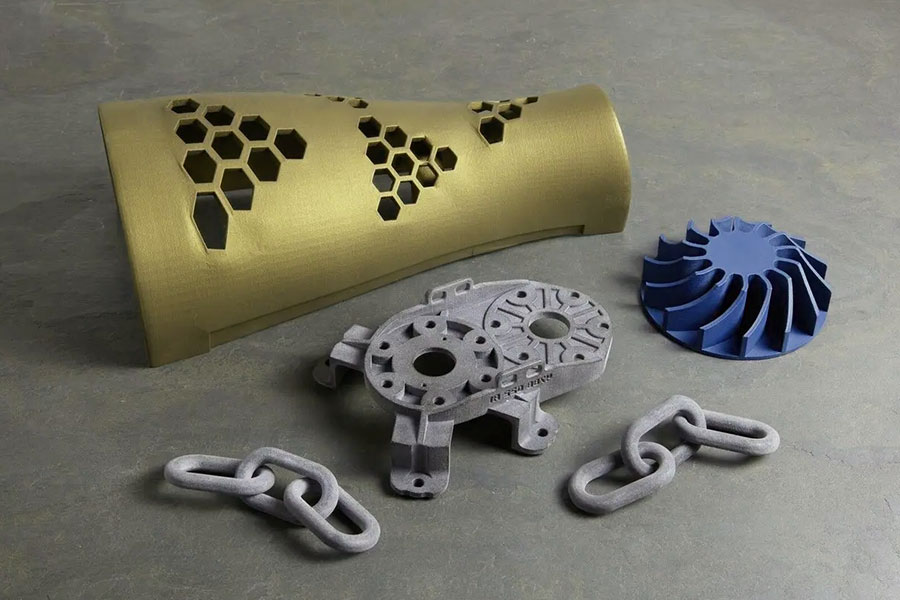
How Does SLS Compare to Other 3D Printing Methods?
1.SLS vs. SLA (stereolithography):
- SLA technology solidifies liquid resin by laser irradiation, thus producing a very smooth surface quality.
- In contrast, SLS technology uses powdered materials and consolidates them through laser sintering. The resulting parts generally have stronger internal structures and higher mechanical strength, although their surfaces may require additional processing to achieve smoothness.
2.SLS vs. FDM (Fused Deposition Modeling):
- FDM technology builds objects layer by layer by extruding thermoplastic materials, which is relatively cost-effective and easy to operate and maintain.
- However, SLS technology generally provides greater precision and better bonding between layers, resulting in more durable and stronger parts. In addition, SLS uses a wider range of powder materials, including high-performance materials such as nylon and TPU.
3.SLS vs. SLM (Selective Laser Melting):
- SLM technology is specially designed for metal printing. It uses high-energy laser beams to completely melt and solidify metal powder into a solid, which is suitable for manufacturing high-precision metal parts.
- In contrast, SLS technology mainly focuses on sintering polymer (plastic) powders. Although it can also handle certain composite materials and ceramic materials, it does not have the advantages of SLM inmetal printing.
What Are the Applications of Selective Laser Sintering?
Selective laser sintering (SLS) technology has found wide applications in many fields with its unique advantages. The following is a detailed description of its application areas:
1.Aerospace industry
Selective laser sintering (SLS) technology has demonstrated its unique application value in the aerospace field. The industry has adopted SLS technology with the aim of reducing manufacturing cycle times. Engineers use additive manufacturing technology to manufacture parts, a change that not only reduces costs but also significantly shortens production time. Advances in the aerospace industry have also benefited from the development of new high-temperature materials. Additive manufacturing has long been an important part of aerospace applications. Recent technological advances have shown that SLS technology can further improve the operational efficiency of the aerospace supply chain. In the aerospace field, SLS technology has had a profound impact from product design and parts production to assembly and maintenance. As an efficient means of rapid prototyping, it saves the industry valuable time and money throughout the product development cycle.
2.Medical industry
The medical industry is gradually increasing its adoption of selective laser sintering (SLS) technology. Although SLS technology was originally designed for manufacturing, it has shown great potential and attracted widespread attention in the medical field. Traditional manufacturing methods for surgical instruments and implant-grade materials rely primarily on casting or machining. However, with the application of SLS printers, the medical industry can quickly produce models, tools and parts. In fields such as orthopedics, biomedical engineering, dentistry, and neurosurgery, SLS technology has been used to create structural models. These models play an important role in medical diagnosis, treatment planning and implant manufacturing. In addition, SLS technology is being intensively studied to create implants with unique geometric properties, such as tissue repair scaffolds. With the advancement of technology, the SLS model has proven its effectiveness in a variety of surgical procedures and is expected to open up more applications in the medical field.
3.Automotive industry
Theapplication of selective laser sintering (SLS) technology in the automotive industryis not surprising, especially considering the continuous technological innovation in this industry. SLS technology is not only used in mass production car manufacturing, but also helps racing teams develop innovative designs and test them at faster speeds. Formula 1 is an excellent example of a racing organization successfully leveraging SLS 3D printing technology, enabling parts to be rapidly produced, tested and optimized to ensure superior performance. In addition to core and complex components, SLS technology plays a key role in the design of the racing aerodynamic structure.
4.Rapid prototyping applications
Compared with other additive manufacturing processes,Selective Laser Sintering (SLS) technology produces materialswith similar properties to machined parts. This means SLS parts can be used for functional testing and marketing demonstrations, accelerating time to market for new or improved products. As SLS technology becomes more widely used in today's society, the challenges of bringing products to a wider market have been significantly reduced.
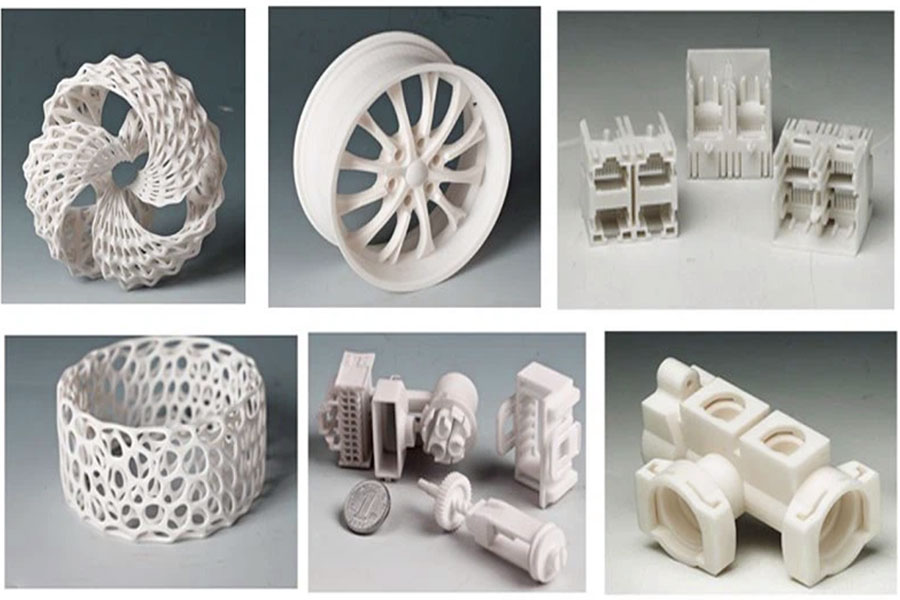
What Are the Common Post-Processing Methods for SLS Parts?
SLS (Selective Laser Sintering) parts can be post-processed in a variety of ways to improve the surface quality, performance and specific application needs of the part. Here are some commonSLS part post-processing methods:
- Powder removal:After the part is formed, excess powder will adhere to the surface and needs to be removed. Generally, most of the surrounding powder is swept away with a brush. The remaining powder can be removed by mechanical vibration, microwave vibration, wind blowing from different directions or compressed air. In addition, the formed parts can also be immersed in a special solvent. The solvent can dissolve the scattered powder, but will not dissolve the solidified and formed parts, thereby achieving the purpose of powder removal.
- Surface grinding:Thepurpose of grinding is to remove various burrs and processing lines on the part blank, and to repair details that are missed or cannot be processed during processing. Sanding is usually divided into primary polishing and secondary polishing, which is done by hand. The commonly used tools are files and sandpaper. For one-time polishing, use two or more types of sandpaper from 180 to 360 grit in order from coarse to fine until the surface of the workpiece feels smooth. Secondary polishing is carried out after the sprayed resin mixture has dried. Use 360~600 grit sandpaper to polish the surface of the workpiece to a thickness of 35~50μm to ensure good adhesion between the surface of the workpiece and the topcoat.
- Surface sandblasting:Use spray material with a size of 75~115μm (such as glass yarn, alumina sand, ceramic sand, etc.) to sandblast the surface of the part. Sandblasting can not only blow off excess powder on the surface of the workpiece, but also impact and grind the surface of the workpiece, causing slight deformation of the surface, thereby eliminating part of the residual stress after processing, improving the mechanical properties of the workpiece surface, improving fatigue resistance, and enhancing its adhesion to the coating.
- Spraying and dipping: Spraying is to spray a specific resin mixture(such as epoxy resin, EP curing agent, absolute alcohol, etc.) or polyester paint mixture on the surface of the part to form a protective layer or decorative layer. The sprayed resin layer can fill the unevenness of the surface particles of the part and enhance the surface hardness. Impregnation is to immerse liquid non-metallic substances into the pores of the porous SLS body. The size of the impregnated parts changes little. The drying process requires controlling parameters such as temperature, humidity, and air flow.
- Heat treatment:For parts such as metal or ceramic powder that have been laser sintered,heat treatment is required to further improve their mechanicaland thermal properties. Heat treatment includes steps such as heating, holding and cooling. Through atomic diffusion and other methods, the shape of the sintered part is maintained and the density and strength are improved.
- Polishing:Polishing is the further smoothing treatment of the surface of the part to obtain a higher surface finish and gloss. Polishing is usually done using tools such as polishing paste and polishing cloth.
- Coating:Coating is to apply a layer of waterproof, anti-corrosion, strong and beautiful protective layer on the surface of parts to improve the service life and aesthetics of the parts. Commonly usedcoating materials include various coatings, paints, etc.
Why choose LS’s online 3D printing service?
- Multi-material processing:We have the ability to process a variety of materials, no matter what material parts you need to process, we canprovide professional solutions.
- Competitive prices:We provide competitive prices and cost-effective solutions to ensure customers gain the greatest advantage in cost control.
- Customized Services:Provide customized solutions based on customers’ design requirements and specifications to ensure parts meet their unique needs.
- Fast delivery:We have efficient production processes and flexible production plans, allowing us to deliver customer orders in a timely manner and meet urgent project needs.
Summary
Selective laser sintering (SLS) uses a high-energy laser beam to scan and sinter powder materials layer by layer to build a three-dimensional solid model. This technology combines the advantages of computer-aided design (CAD) and laser technology to bring revolutionary changes to the manufacturing industry. Selective laser sintering (SLS) technology, as an advanced rapid prototyping technology, has broad application prospects and huge development potential in manufacturing. Through continuous technological innovation and application expansion, SLS technology will bring more innovation and changes to the manufacturing industry.
Disclaimer
The content on this page is for reference only.LSdoes not make any express or implied representation or warranty as to the accuracy, completeness or validity of the information. No performance parameters, geometric tolerances, specific design features, material quality and type or workmanship should be inferred as to what a third party supplier or manufacturer will deliver through the Longsheng Network. It is the responsibility of the buyerseeking a quote for partsto determine the specific requirements for those parts.Pleasecontact usfor moreinformation.
LS Team
LS is an industry-leading companyspecializing in custom manufacturing solutions. With over 20 years of experience serving more than 5,000 clients, we focus on high-precisionCNC machining,sheet metal fabrication,3D printing,injection molding,metal stamping,and other one-stop manufacturing services.
Our factory is equipped with more than 100 advanced 5-axis machining centers and is ISO 9001:2015 certified. We provide fast, efficient, and high-quality manufacturing solutions to customers in over 150 countries worldwide. Whether it’s low-volume production or large-scale customization, we can meet your needs with delivery as fast as 24 hours. ChoosingLS Technologymeans choosing efficiency, quality, and professionalism.
To learn more, please visit our website:www.lsrpf.com
FAQs
1.How Does selective laser sintering Work?
The working principle of selective laser sintering is based on the discrete-stacking principle. First, the powder material is preheated to a temperature slightly below its melting point, and then under computer control, the laser beam selectively sinters based on layered cross-section information. After one layer of sintering is completed, the workbench is lowered by one layer, and a new layer of powder is spread, and a new layer of cross-section is sintered. This is repeated until the entire three-dimensional solid structure is completed.
2.What is the role of the laser beam during the SLS process?
In the SLS process, the main role of the laser beam is to provide energy to quickly melt and bond the powder particles together. The scanning path and power of the laser beam are precisely controlled based on the slicing data to ensure the accuracy and precision of sintering.
3.What is the role of the laser beam during the SLS process?
In the SLS process, the main role of the laser beam is to provide energy to quickly melt and bond the powder particles together. The scanning path and power of the laser beam are precisely controlled based on the slicing data to ensure the accuracy and precision of sintering.
4.What is the future outlook for selective laser sintering technology?
With the continuous advancement and innovation of technology, SLS technology is expected to be further improved in terms of speed, accuracy, material selection range, and post-processing capabilities. This will promote the application and development of SLS technology in more fields and bring more efficient, flexible and personalized production methods to the manufacturing industry.
Resource
2.Study on high temperature sintering processes of selective laser sintered Al2O3/ZrO2/TiC ceramics




